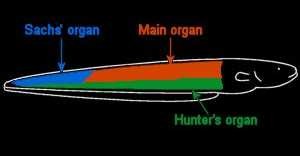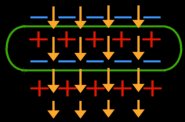 The electric eel, unlike most electric fish, has three separate organs which it
uses for producing a charge. The need for three electric organs is to fulfill
the various roles and applications of its ability to produce electricity. The
Main and Hunters' organs are the high voltage producers, used for protection,
fright reflexes and stunning prey. The Sachs' organ is capable only of producing
low voltage pulses - its purpose is mainly electro communication and navigation.
The eel, spite being slightly curved in the above picture, tends to remain
straight whilst moving, using its anal fin to propel itself. This is necessary
in order to maintain a uniform electric field around itself, as a more effective
sensory mechanism.
The electric eel, unlike most electric fish, has three separate organs which it
uses for producing a charge. The need for three electric organs is to fulfill
the various roles and applications of its ability to produce electricity. The
Main and Hunters' organs are the high voltage producers, used for protection,
fright reflexes and stunning prey. The Sachs' organ is capable only of producing
low voltage pulses - its purpose is mainly electro communication and navigation.
The eel, spite being slightly curved in the above picture, tends to remain
straight whilst moving, using its anal fin to propel itself. This is necessary
in order to maintain a uniform electric field around itself, as a more effective
sensory mechanism.

The electric organs, responsible for the discharge, are composed of
muscle-like cells called electrocytes. These cells resemble muscle cells in the
sense that they exist at the end of axons or nerve cells, as a muscle cell
would, only the electrocytes have no contracting ability. Having a distinctly
disc like form, the electrocytes can be aligned as cells in a battery.
Up to 200,000 of these cells can be aligned in series within the
organ....each one capable of producing a small voltage so that when discharged
simultaneously, the resulting potential difference is the sum of each of these
voltages. In the low voltage organs, electric discharge varies considerably from
fish to fish. Some species produce a continual wave-like discharge, whereas
others emit a constant pulse. The higher voltage organs emit a pulse, but they
remain inactive most of the time, recharging for a large accumulated discharge
in the event of danger.
Electric eels are classified as strongly electric fish as opposed to
weakly electric fish, the Torpedo ray is another strongly electric fish.
Electric discharge is therefore of the "pulse" like nature.
Electrocytes, like all eukaryotic cells, maintain a potential gradient
across the membrane, this is done by active transport of Na+ and K+
ions through membrane
pumps, protein structures which span the phospholipid bilayers forming the
cell membrane. Transport of these ions is coupled to the synthesis of ATP, the
standard currency of energy in all biological
organisms.
Whilst not in use, the electrocytes have a net negative charge
inside the cell;

This is the result of a net efflux of Na+ ions through
the sodium potassium pumps. Although the intracellular concentration of K+
is high, potassium ions flow out of the cell under the influence of a
concentration gradient (due to there being a higher concentration of K+
inside the cell) . The extracellular positive charge now increase as
the cytosolic (inside the cell) negative charge becomes more
negative......eventually the concentration gradient and the potential difference
cancel each other out, a state of equilibrium has developed whereby the inside
of the electrocyte is negatively charged and the outside has a net positive
charge. The concentration and potential difference can be equated by the Nernst
equation;
 click here for a chart of cellular ion
concentrations
click here for a chart of cellular ion
concentrations
Where
R is the molar gas constant, T is the temperature (in Kelvin), z is the charge
of the ion, F is the Faraday constant, Co ans Ci are the
ion concentrations outside and inside the cell respectively.
When
in use, ie on stimulation by a motor neuron, the innervated
(side of the cell which is attached to a nerve ending) side of the cell becomes
depolarised before the uninnervated side. This gives rise to a temporary
potential gradient on each membrane pointing in the same direction, which is
then discharged.

Leading up to the discharge, the
motorneuron delivers a nerve impulse from the brain, which, when it reaches the
electrocyte, causes the activation of acetylcholine. Acetylcholine can diffuse
across the synaptic cleft (the gap between the end of the motorneuron and the
electrocyte), and into an acetylcholine receptor on the cell membrane causing an
ion channel to open. extracellular ions can then enter the cell and the
depolarization occurs. The
discharge of electricity out of the cell has to be synchronized with the 200,000 other
electrocytes, this is done by a combination of three features in the
motorneurons.
Previous
Page
Next Page
 The electric eel, unlike most electric fish, has three separate organs which it
uses for producing a charge. The need for three electric organs is to fulfill
the various roles and applications of its ability to produce electricity. The
Main and Hunters' organs are the high voltage producers, used for protection,
fright reflexes and stunning prey. The Sachs' organ is capable only of producing
low voltage pulses - its purpose is mainly electro communication and navigation.
The eel, spite being slightly curved in the above picture, tends to remain
straight whilst moving, using its anal fin to propel itself. This is necessary
in order to maintain a uniform electric field around itself, as a more effective
sensory mechanism.
The electric eel, unlike most electric fish, has three separate organs which it
uses for producing a charge. The need for three electric organs is to fulfill
the various roles and applications of its ability to produce electricity. The
Main and Hunters' organs are the high voltage producers, used for protection,
fright reflexes and stunning prey. The Sachs' organ is capable only of producing
low voltage pulses - its purpose is mainly electro communication and navigation.
The eel, spite being slightly curved in the above picture, tends to remain
straight whilst moving, using its anal fin to propel itself. This is necessary
in order to maintain a uniform electric field around itself, as a more effective
sensory mechanism.

